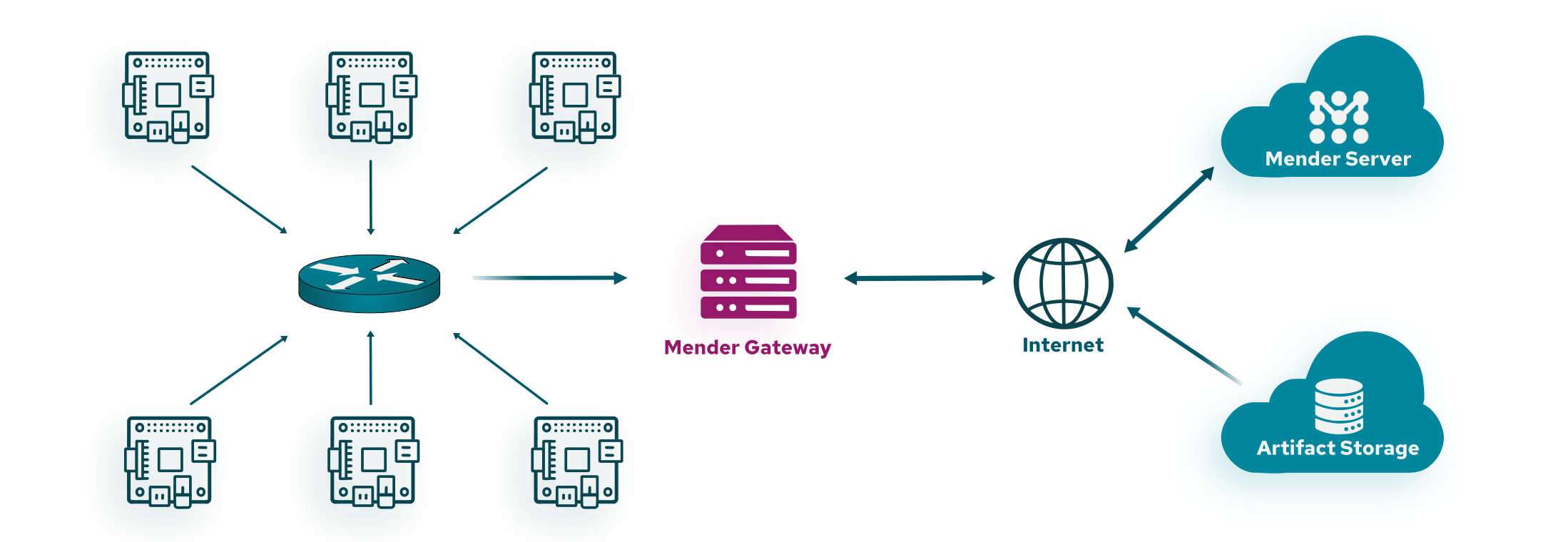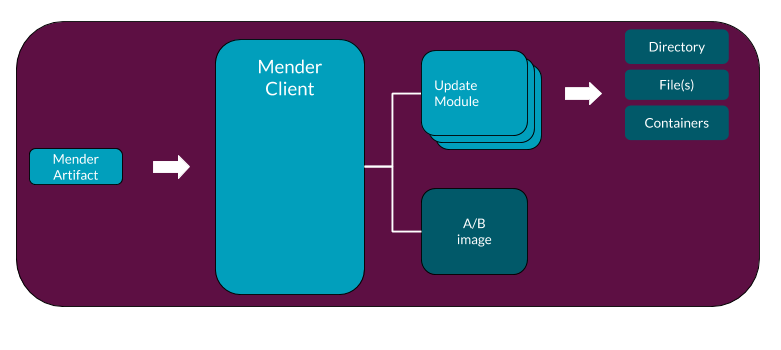Introduction
Mender is a secure and robust software update system designed to handle a large number of devices. It has a simple client/server architecture allowing central management of deployments to all devices.
Mender also supports powerful extensions in the form of add-ons that enable features like Remote Terminal, Port Forward, File Transfer, and Device Configuration, together with the ability to monitor and alert with the Monitor add-on.
The architecture of a software update
The following diagram shows the high level flow of data involved in deploying software updates.

The process begins with the build system generating a new software version for a device. The build system can be a workstation creating a simple application update or a more standard component, such as Jenkins and Yocto Project. It creates Mender Artifacts in the format required by the target device. There will be different Mender Artifacts for each type of device that Mender manages.
You upload the Mender Artifacts to the Mender Server, which is the central point for deploying updates to a fleet of devices. Among other things, it monitors the current software version present on each device and schedules the roll out of new releases.
Finally, each Device runs the Mender Client, which polls the Mender Server periodically to report its status and to discover if there is a software update waiting. If there is, the update client downloads the artifact and performs the installation.
The current Mender Client supports devices running embedded Linux, and other clients exist for other OSes and hardware, such as microcontrollers.
Client modes of operation
You can run the Mender Client in a standalone or managed mode.
In managed mode, the Mender Client runs as a daemon and will regularly poll the server, automatically apply updates, reboot, report, and commit the update. This is the best way to run Mender for most large-scale deployments, as the deployments are centrally managed across many devices, but it requires to set up and connect clients to the Mender Server.
In standalone mode, you initiate the updates locally on the device instead of connecting the Mender Client to a Mender Server. A common use-case is to perform updates from e.g., a USB flash drive. To learn more visit Standalone deployments
Mender Gateway
For devices running in isolated networks, but still want to leverage the flexibility of managed mode, the Mender Gateway offers the ability for devices to securely contact the Mender Server through your gateway device. Visit Mender Gateway to learn more.

Update types
Robust Operating System updates
One of the primary requirements of any update system is that it should be robust. It must be able to recover from an update that fails, including loss of power or network connectivity during the update process.
The simplest and most robust way to update a device is to write a new file system image directly to the flash partition. Mender comes with built-in support for a dual redundant scheme (also known as A/B scheme), ensuring that the device always returns to a working state on failure.
During the Operating System update, the client writes the new version to the inactive partition. When complete, the client verifies the checksum. If all is well, it sets a flag in the bootloader that will cause it to flip the active and inactive partitions around on the next reboot. Then the system reboots.
On the first boot following an update, the Mender Client will commit the update. This sets a flag in the bootloader that indicates that the update was applied successfully.
If something causes the device to reboot before committing the update, the bootloader knows that something went wrong and will roll back to the previous version by flipping the active and inactive partitions back again.
One consequence of the Operating System update is that the update will replace all the files in a filesystem, thereby deleting any new or changed files that had been placed there. In other words, to be updatable, a filesystem needs to be stateless.
You have to store all files that you modify on the devices in a separate partition. It may include network parameters, user configuration changes, etc.
Application updates
The definition of an application update can vary depending on specific user requirements, e.g an application can be a single file, directory or even a container image. For this reason it is difficult to enforce one way of deploying application updates.
To support application updates in a generic way, Mender provides the Update Module framework.

Combining Operating System and Application updates
A common requirement when performing software updates on connected devices is combining Operating System and Application updates. Operating System updates represent the only secure and robust way to upgrade the kernel, the operating system, and related libraries, avoiding the risk of bricking the device. However, they come with the price of the downtime caused by the system reboot and, when delta updates are not in use, the higher amount of data usage because of the need to transfer an artifact containing the full rootfs image.
In contrast, application updates implemented through the Update Module framework are more flexible when the update scenario requires the replacement of a subset of the files on the device's firmware and doesn't require a complete device reboot cycle to apply the changes.
Mender allows combining Operating System and Application updates on the same device to achieve the best flexibility without compromising the specific advantages of the two approaches. When generating the Mender Artifacts, you can customize the Software Versioning values, as well as Depends and Provides entries in the Artifacts to define dependencies between the different kinds of updates.
You can find more information about the strategies and best practices to combine Operating System and Application updates in the Combining system and application updates chapter.
Please note that in this context, while it is technically possible to use the Update Module API to implement Operating System updates, we refer to application updates as non-rootfs ones.
Proxy deployments
Using the Update Module framework it is also possible to deploy updates to peripheral devices, e.g microcontrollers or sensors connected to a device running Linux.
Example using the Device Firmware Upgrade (DFU) protocol to update an external microcontroller:

You can find more information on above example in the How to do a proxy deployment to an FRDM-K64F tutorial.
The architecture of a Mender add-on
Mender supports add-ons mainly via the Mender Connect daemon running on a device. It is exchanging messages with the client over DBus. The below picture shows the architecture of the solution.

Please refer to the Add-ons section for more details.